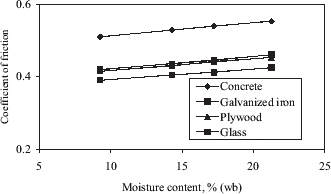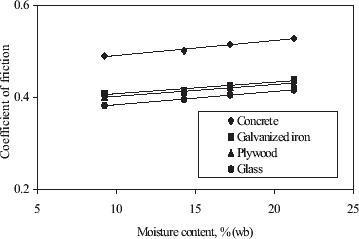Abstract
This study was carried out to determine the effect of moisture content on coefficient of friction of chickpea, khesari, blackgram, cowpea, fieldpea, mungbean, and lentil. The material generally moves or slides in direct contact with trough, casing, and other components of the machine. Various parameters affect the power requirement to drive the machine. The frictional losses are one of the factors, which must be overcome by providing additional power to the machine. Four levels of moisture contents of chickpea, khesari, blackgram, cowpea, fieldpea, mungbean, and lentil ranging from 8.76 to 22.38% (wet basis) were considered in this study. Static and kinetic coefficients of friction of these pulses were determined over smooth concrete surface, galvanized iron sheet, plywood, and glass sheet. They were varied from materials to materials and depended on the roughness and wetness of the grain. The highest coefficient of friction of static and kinetic was found over concrete surface and lowest for glass sheet among the materials tested. The highest value of coefficient of friction of static and kinetic has been found for chickpea, which indicates its rough surface than those of other, six. The static coefficient of friction irrespective of grain and surface types was always greater than the kinetic coefficient of friction.
Introduction
Pulses are major and cheap sources of protein in the daily meals of the people of Bangladesh. It has good digestibility, flavor, and high protein content. It has the ability to overcome malnutrition problems due to riches in protein (23–24%) of the poor masses.Citation[1] In Bangladesh, about 0.3 million tons of pulses are produced from 0.48 million hectares of land.Citation[2]
Recently scientists have made great efforts in evaluating basic physical properties of agricultural materials and have pointed out their practical utility in machine and structural design and in process and control engineering.Citation[3] The recent scientific development have improved the handling and processing of bio-materials through mechanical, thermal, electrical, optical, and other technique, a little is known about the basic physical characteristics of bio-materials. Such basic information is important not only to engineers but also to food scientists, processors, plant breeders, and other scientists who may find new uses.Citation[4] Coefficient of friction is important in designing storage bins, hoppers, chutes, screw conveyors, forage harvesters, and threshers. The material generally moves or slides in direct contact with trough, casing, and other components of the machine. The various parameters affect the power requirement to drive the machine. The frictional losses are one of the factors, which must be overcome by providing additional power to the machine. Hence, the knowledge of coefficient of friction of the agricultural materials is necessary.
Many investigators determined the coefficient of friction of different pulse and oilseeds on various surfaces such as gram and pigeon pea,Citation[5] for groundnut kernels,Citation[6] Citation[7] and for gram.Citation[8] The moisture dependent coefficients of friction of pulses grown in Bangladesh are not available in literature. So this study has been undertaken to determine the coefficient of friction of pulses at various moisture content on different surfaces.
Materials and Methods
Sample Preparation
This study was conducted at Farm Machinery and Postharvest Process Engineering Division in Bangladesh Agricultural Research Institute (BARI) during April–May 2003. Dried pulses were collected from Pulse Research Centre of BARI. The initial moisture content was determined by drying samples in an air ventilated oven at 103°C temperature for 72 h.Citation[9] The samples of the selected moisture content were determined by adding calculated amount of water and sealing them in separate polyethylene bags and stored in a refrigerator at 7°C. Before each experiment, the required sample was taken out from the refrigerator and kept in ambient condition for 24 h to equilibrate the water and temperature throughout the sample. Static and kinetic coefficients of friction of BARI chickpea-1, BARI khesari-1, BARI blackgram-1, BARI cowpea-1, BARI fieldpea-1, BARI mungbean-5, and BARI lentil-1 were determined at four moisture contents ranging from 9.25–21.25, 10.28–22.28, 10.38–22.38, 8.76–20.76, 10.21–22.21, 9.14–21.14, and 10.33–21.00% (wb), respectively. Static and kinetic coefficient of friction of each pulse group were determined on four surfaces such as smooth concrete, galvanized iron sheet, plywood, and glass sheet.
Determination of Coefficient of Friction
The static and kinetic coefficients of friction of each variety were determined on concrete surface, galvanized iron sheet, plywood, and glass sheet. It was determined on each surface by filling a hollow plastic box of dimensions 70 mm × 70 mm × 70 mm with kernels.Citation[6] The box was pulled parallel to the surface in such a way that it just started to move and static coefficient of friction (μ 0) was determined by using the formula:
Results and Discussion
The static and kinetic coefficients of friction of chickpea, khesari, blackgram, cowpea, fieldpea, mungbean, and lentil on concrete surface, galvanized iron sheet, plywood, and glass sheet at different moisture content levels are presented in Table . It is observed from the Table that the static and kinetic frictional of pulses on all surfaces increased with the increase of moisture content. It is also observed that the static coefficients of friction were found to be greater than kinetic coefficients of friction in all cases. This finding is supported by the results for groundnut kernelCitation[7] and gram.Citation[8] The highest static and kinetic coefficients of friction were obtained for concrete surface and the lowest coefficients of friction were found for glass sheet for all types of pulse grains. This indicates that concrete surface poses rough surface and glass sheet poses smooth surface. The highest static and kinetic coefficients of friction were found for chickpea and the lowest for lentil. This may be due to the fact that the size of grain of chickpea is larger than that of lentil. On the other hand, it is visually observed that the surface roughness of chickpea is greater than that of lentil grains due to their generic variations. The change of a typical static and kinetic coefficients of friction with moisture contents and their corresponding regression lines on various surfaces for chickpea grains are shown in Figs. and , respectively. It is observed from the figures that in all cases the static and kinetic coefficients of friction increased linearly with the increase of moisture content. Both static and kinetic coefficients friction on concrete surface are found to be much higher than those of other surfaces. The coefficients of friction on galvanized iron and plywood surfaces are similar and closer to each other but little higher than that of glass surface. The regression equations of coefficients of determination all pulse grains on various surfaces are presented in Table . These data may be used for designing of storage bins, hoppers, chutes, screw conveyors, harvesters, and threshers etc., with the studied materials at different moisture content in the data range.
Table 1 Static and kinetic coefficient of friction of pulses on various surfaces at different moisture content levels
Table 2 The regression equations and corresponding coefficient of determination (R 2) of static and kinetic coefficient of friction with moisture content of grains on various surfaces
Conclusions
The static and kinetic coefficients of friction for all varieties increase with the increase of moisture content, and the chickpea has the highest static and kinetic coefficient of friction compared to khesari, blackgram, cowpea, fieldpea, mungbean, and lentil. The coefficients of frictions on concrete surface were found to be higher than other surfaces.
References
- Rajput , M.A. and Sarwar , G. 1988 . Development of high yielding mungbean mutants in Pakistan . Food Legumes Coarse Grain NI , 5 : 3
- Bangladesh Bureau of Statistics. 2000 . Agricultural Yearbook of Bangladesh Dhaka : Statistical Division, Ministry of Planning, Govt. of the People's Bangladesh Republic of Bangladesh .
- Waziri , A.N. and Mittal , J.P. 1983 . Design related physical properties of selected agricultural products . Agricultural Mechanization in Asia, Africa and Latin America , 14 ( 1 ) : 59 – 62 .
- Mohesenin , N.N. 1970 . Physical Properties of Plant and Animal Materials 51 – 87 . New York : Gordon and Breach Science Publishers Inc. .
- Shepherd , H. and Bhardwaj , R.K. 1986 . Moisture dependent physical properties of pigeon pea . Journal of Agricultural Engineering Research , 35 : 227 – 234 .
- Kaleemullah , S. 1992 . The effect on moisture content on the physical properties of groundnut kernels . Tropical Sciences , 32 : 129 – 136 .
- Hossain , M.A. , Khaleque , M.A. and Hassan , M.S. 1998 . Physical characteristics of groundnut true at various moisture contents . Legume Research , 21 ( 2 ) : 79 – 84 .
- Chowdhury , M.M.I. , Sarker , R.I. , Bala , B.K. and Hossain , M.A. 2001 . Physical Properties of gram as a function of moisture content . International Journal of Food Properties , 4 ( 2 ) : 297 – 310 .
- St. Joseph , M.I. 1993 . ASAE. Moisture measurement—unground grain and seeds . In ASAE Standards , : 449 (ASAE-S352.2 Dec 92)

